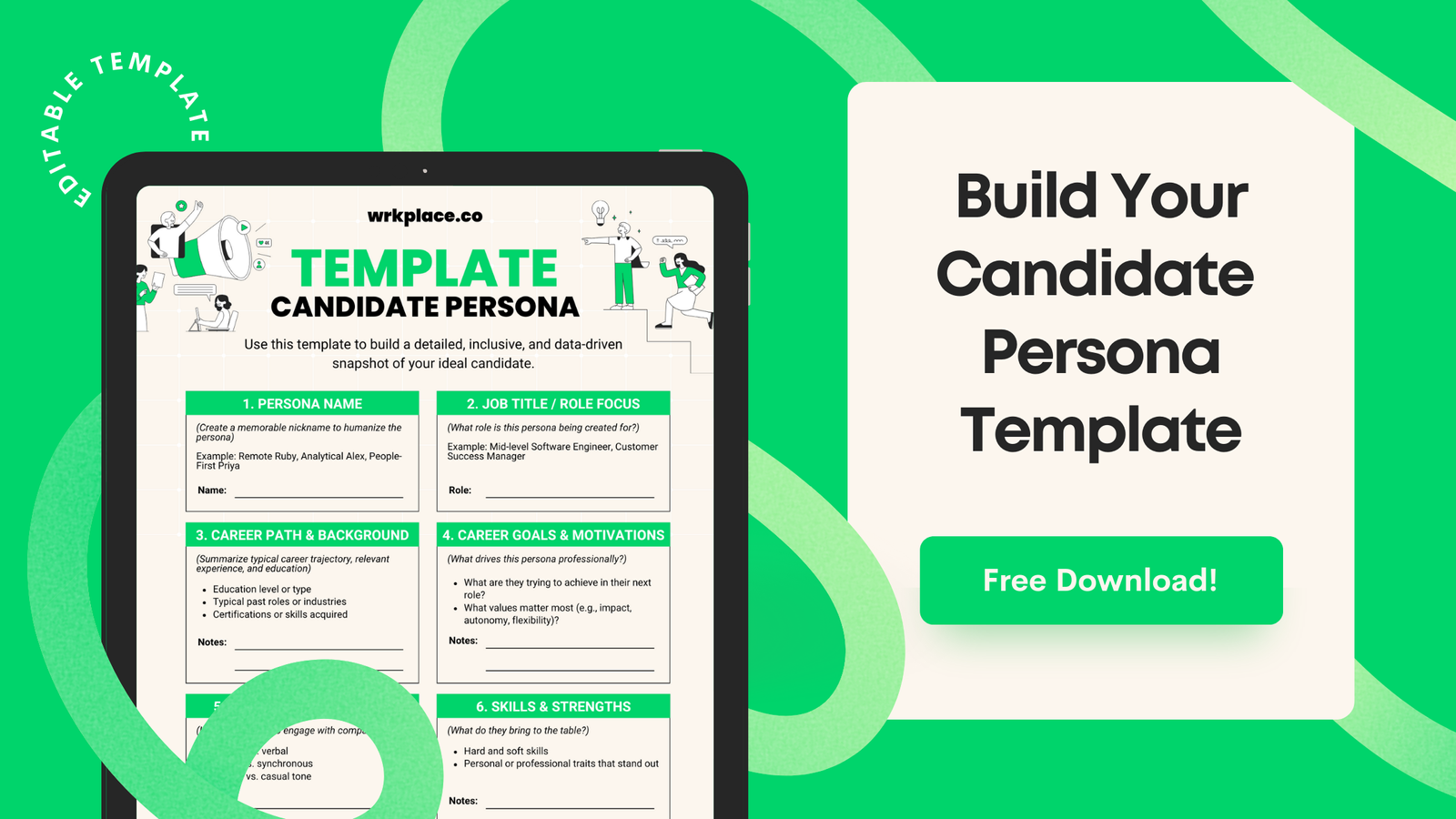If you’re building your employer branding or crafting a smart recruitment marketing strategy, there’s one thing you absolutely can’t skip: candidate personas. Think of them like your north star, keeping your messages relevant, your hiring process focused, and your employer branding speaking to the right people. But what exactly is a candidate persona? And how do you build one? Don’t worry, we’ve got you covered. This guide breaks it all down, step by step. And yes, there’s a free candidate persona template you can swipe at the end!
What Is a Candidate Persona?
A candidate persona is a semi-fictional profile that represents your ideal job candidate. It’s not pulled from thin air, it’s based on real data (think: interviews, application stats, employee feedback) and research.
Instead of assuming what your ideal candidate wants, you actually know because you’ve taken the time to figure it out.
Why Candidate Personas Matter
Ever put out a job post, only to attract the wrong people? Or struggle to connect with talent on social media? That usually happens when messages are too broad or generic.
Candidate personas sharpen your focus. They help you:
- Write better job ads that speak to the right people
- Create targeted recruitment campaigns that drive more applications
- Understand what your audience values, from benefits and communication style to career goals
- Build stronger employer brand messaging that genuinely resonates
If you’re serious about talent attraction, this step isn’t optional.
How to Build a Candidate Persona
Now that you get the “why,” let’s dive into the “how.”
Here’s a straightforward process to create a persona your whole team can rally around.
1. Gather Your Data
Start with the facts. Talk to current employees who fit the kind of person you want to hire. Pull data from your ATS. Look at who’s applying, and who’s actually getting hired.
Some sources to use:
- Exit interviews and stay interviews
- Team feedback and candidate surveys
- DEI data and engagement scores
- LinkedIn and other recruitment analytics
Not every insight needs to be numerical. Anecdotal information counts too as long as it’s real.
2. Identify Patterns
As you review your data, keep an eye out for repeat themes.
For example, do high performers in your sales team all say they value autonomy? Do your top tech hires come from nontraditional backgrounds? These are clues.
Group people by common job goals, motivations, and behavior (not just by age or education). That’s where things get meaningful.
3. Create One Clear Persona
Using what you found, build a detailed snapshot of your ideal hire.
Your candidate persona should include key details like:
- Name (give them a fun placeholder name like “Remote Ruby” or “Analytical Alex”)
- Career goals
- Background (education, experience, career path)
- Skills and strengths
- Motivations and fears
- Preferred work environment
- Challenges they face in job searching
- Where they “hang out” online (Reddit? GitHub? TikTok?)
The goal is to make the persona feel real, like someone you could actually talk to.
4. Check for Bias
Before finalizing your persona, step back. Ask yourself: Are we being inclusive enough?
It’s easy to accidentally create personas that only reflect one type of background or career path. That closes the door to great talent. If your whole team thinks like you, you’re limiting your team’s ability to achieve great things.
Be sure your personas consider diversity in experience, gender identity, race, ability, and even life stage. You don’t want to narrow your hiring funnel unintentionally.
5. Bring It to Life
Now’s the time to take that persona off paper and into action.
Share it with your talent acquisition team. Build campaigns around it. Tailor outreach and job ads based on what this type of candidate responds well to.
Hint: If “Remote Ruby” values flexibility and asynchronous communication, that’s a signal for how you advertise your benefits.
Candidate Persona Examples
To put it all into perspective, here’s a quick example of a simplified persona for a remote software engineer role:
Persona Name: Remote Ruby
- Background: 5+ years in software development, prefers remote-first environments, values mentorship and professional growth
- Motivations: Autonomy, clear work-life boundaries, a sense of purpose
- Fears: High-pressure, micromanaged teams or unclear expectations
- Tools Used: GitHub, Slack, Hacker News, Reddit (r/remotejs)
- Communication Style: Written-first, async preferred
This kind of detail helps your hiring team know how, when, and where to connect with someone like Ruby.
Where Candidate Personas Fit into Recruitment Strategy
You shouldn’t think of personas as one-off documents. They’re tools for alignment across your entire recruitment marketing funnel and employer branding strategy.
Here’s how they plug in:
- Job Ad Copywriting: Target messages based on career goals and pain points.
- Career Site: Make sure content aligns with persona values (benefits, culture, flexibility).
- Recruitment Campaigns: Personalize outreach and retargeting messages for better results.
- Social Recruiting: Focus your content on platforms and communities they already engage with.
Get Your Candidate Persona Template (Free Download)
Ready to create your own? We’ve made it easy with a free candidate persona template that walks you through each section, with prompts, examples, and space to plug in your data.
No guesswork. Just a flexible, super-practical tool you can start using right away.

Final Thoughts
Here’s the truth: companies that truly understand the people they’re trying to hire win the best talent. Full stop.
A candidate persona isn’t just another HR doc, it’s a foundation for all your employer branding, hiring campaigns, and talent messaging. So whether you’re revamping your recruitment strategy or just trying to fill roles faster, starting here sets everything else up for success.
Your next best hire is out there. Let’s make sure your message reaches them.
Need Help With Your Candidate Personas?
If you’re looking for support on Candidate Personas, we’ve got you. Reach out to us or explore more tools in the Templates & Tools section of our Resources hub.






